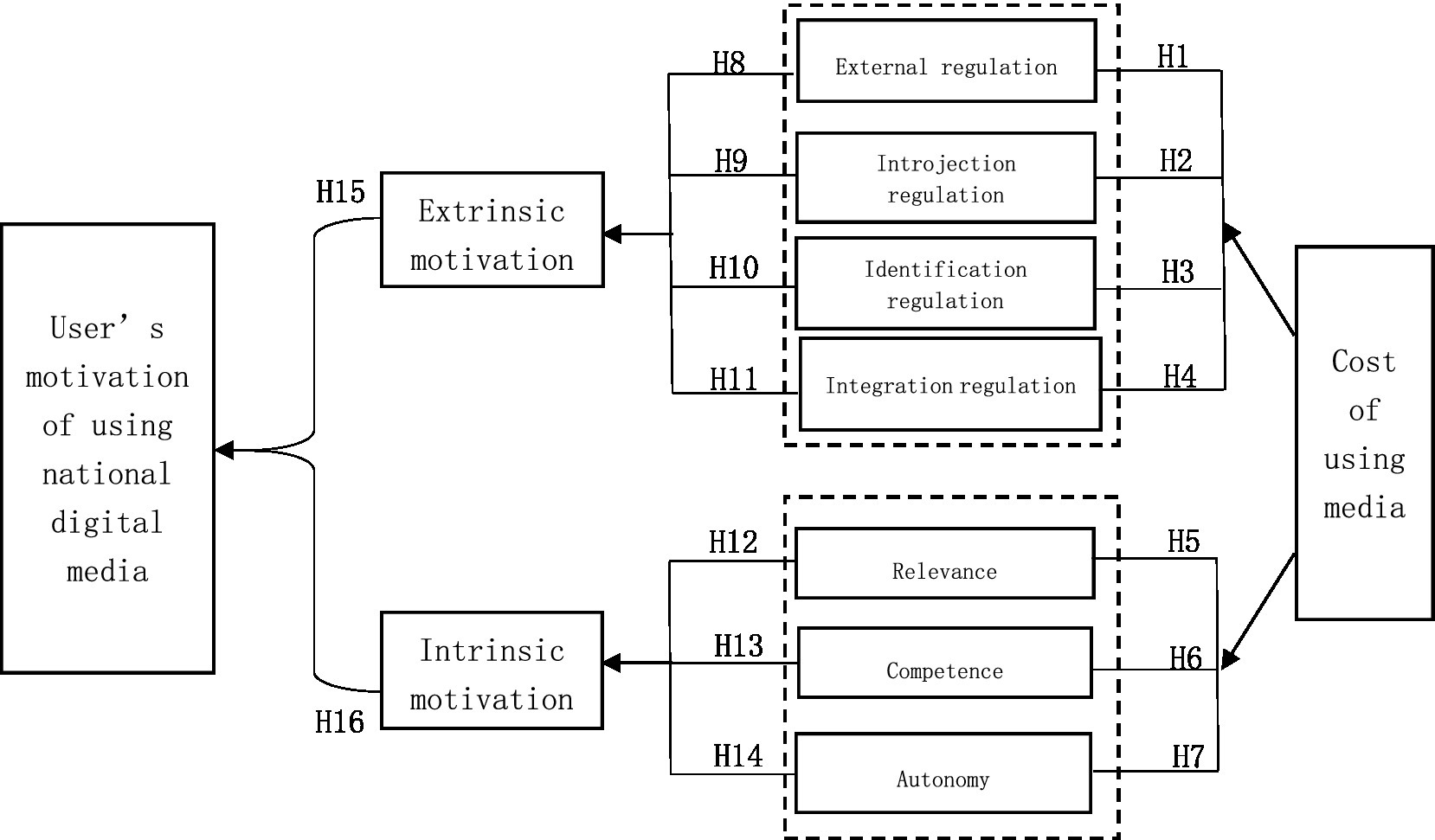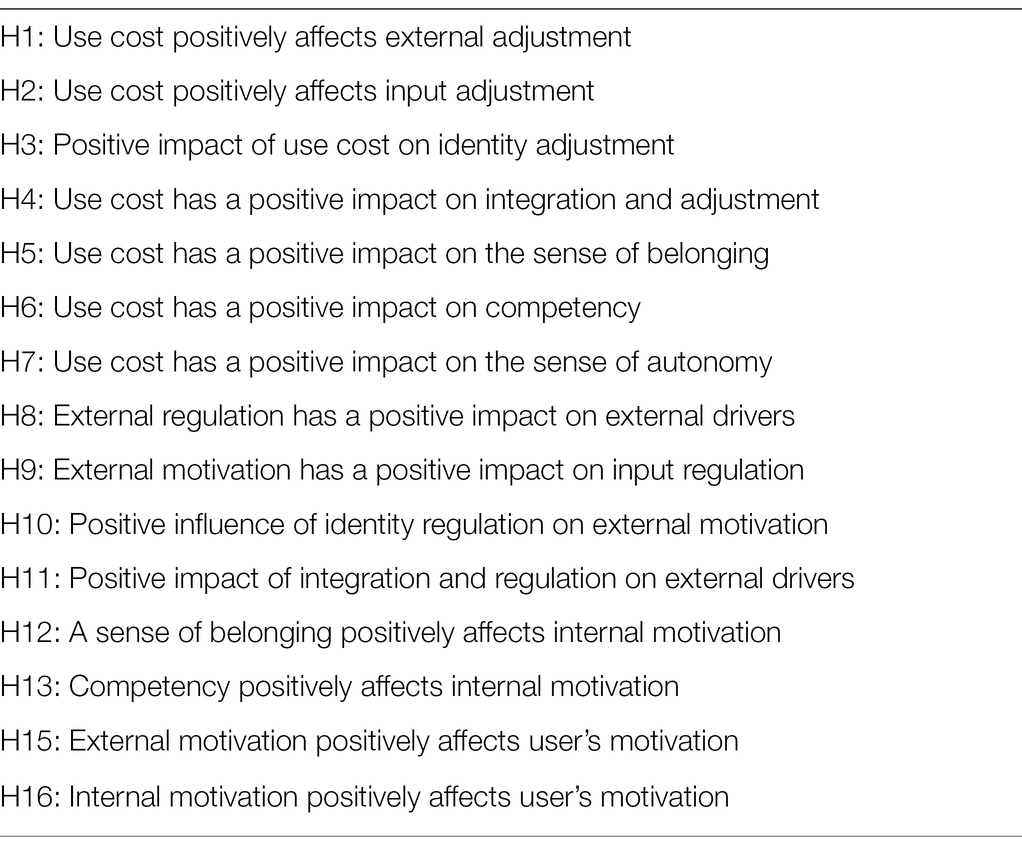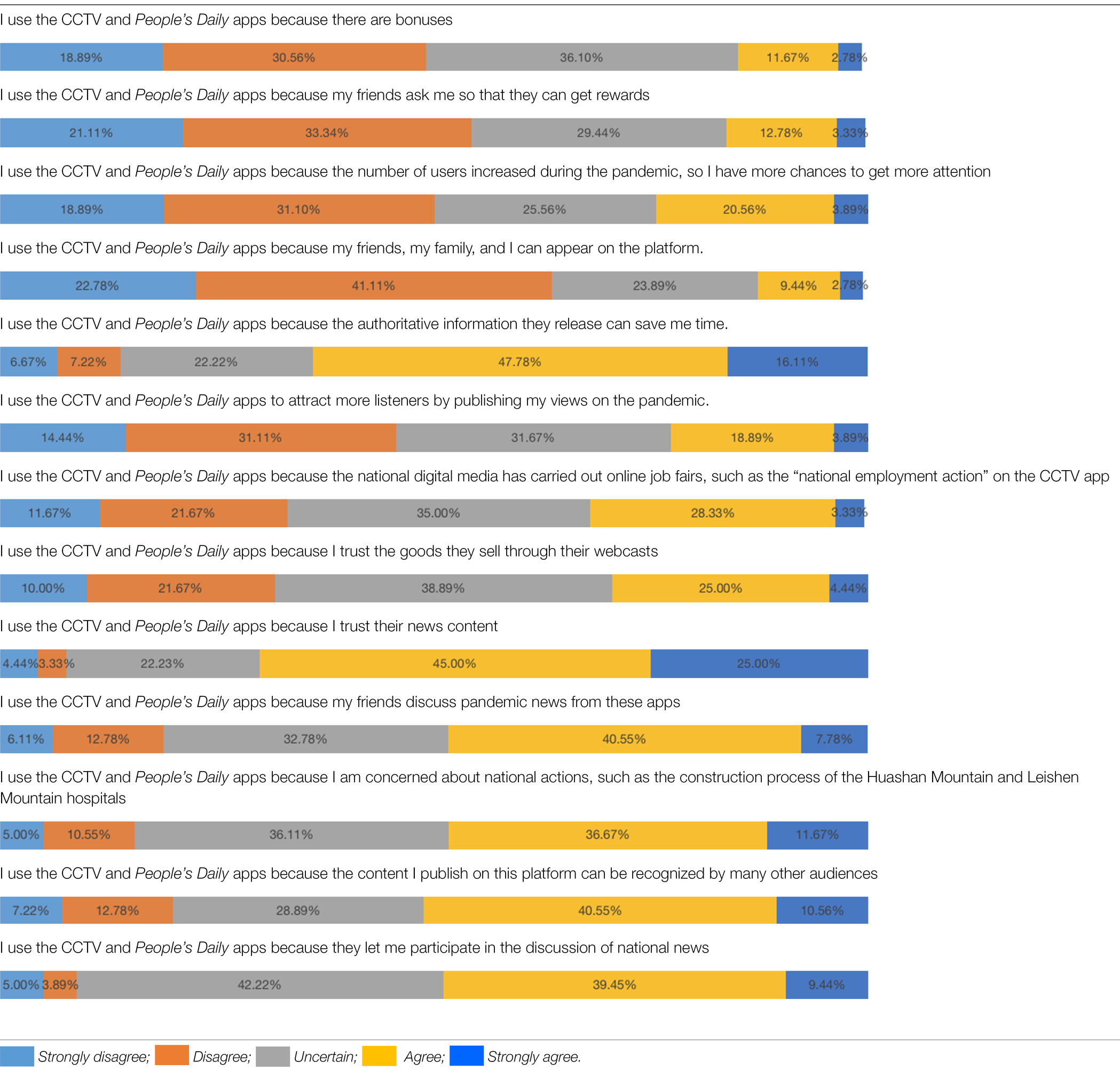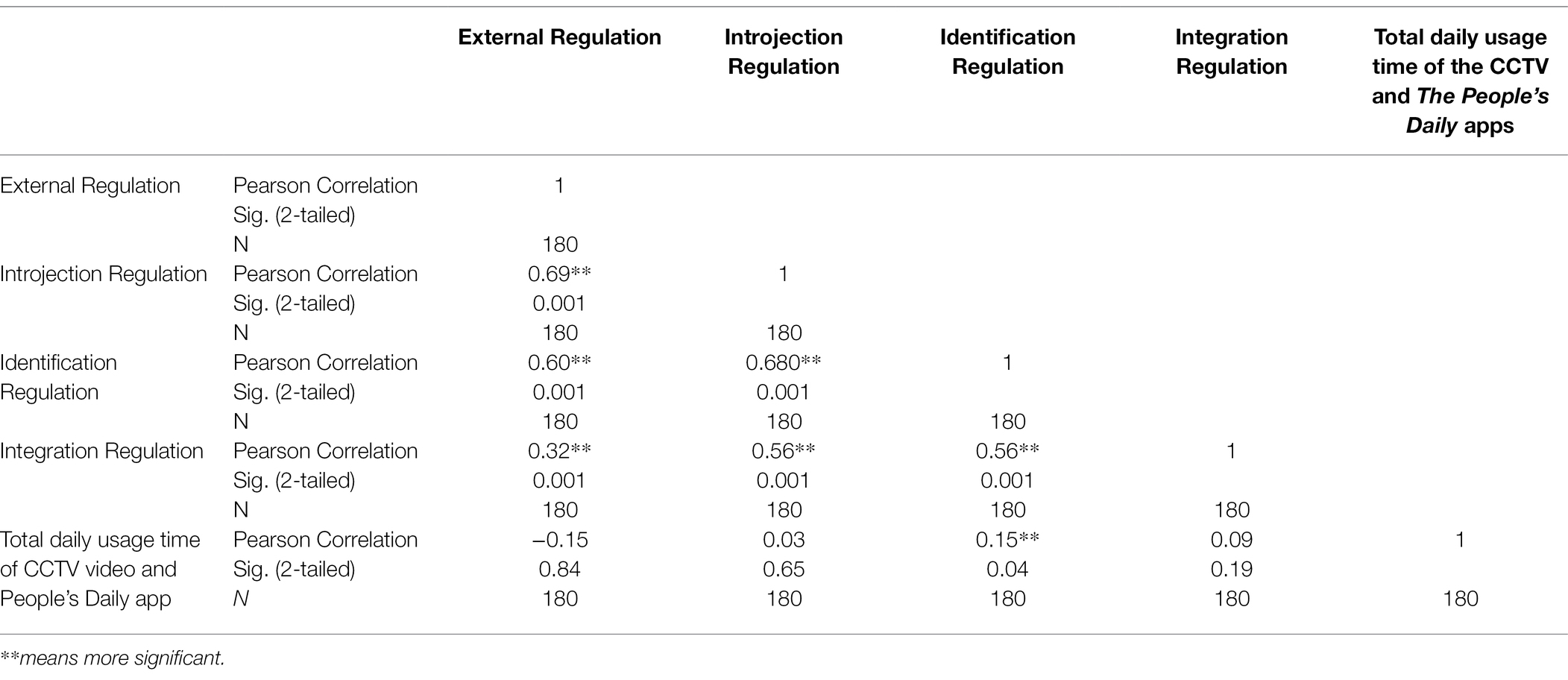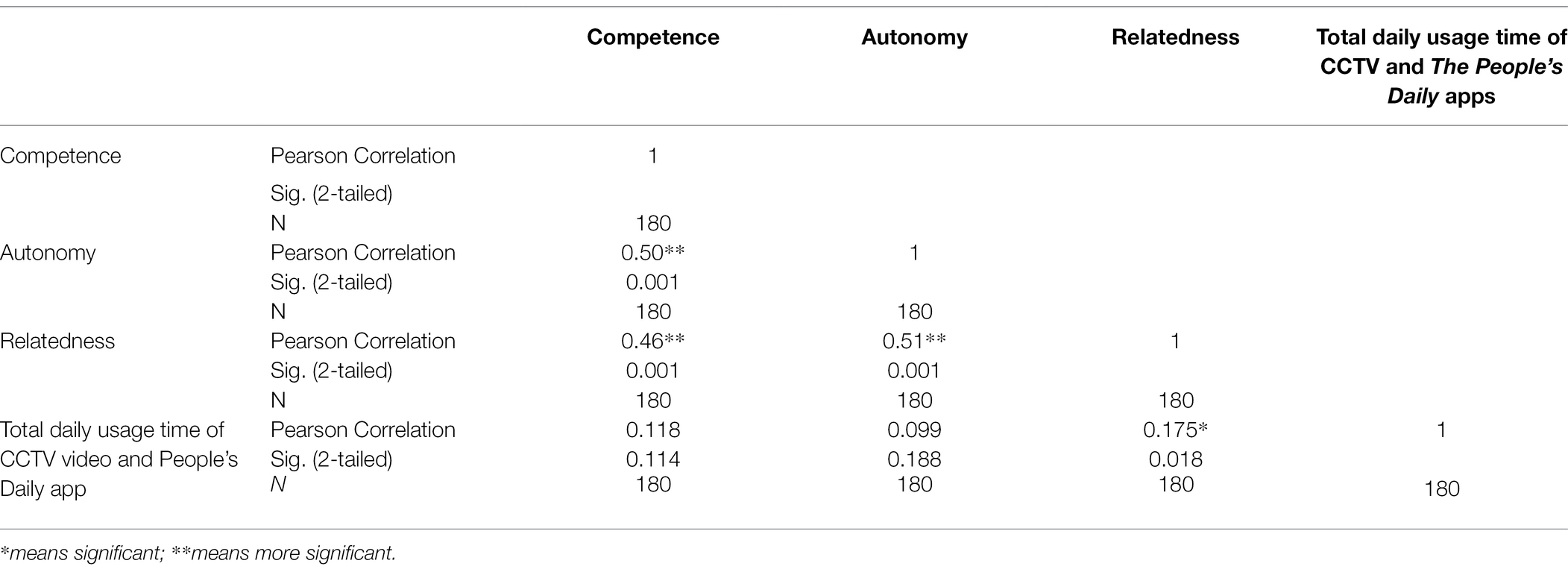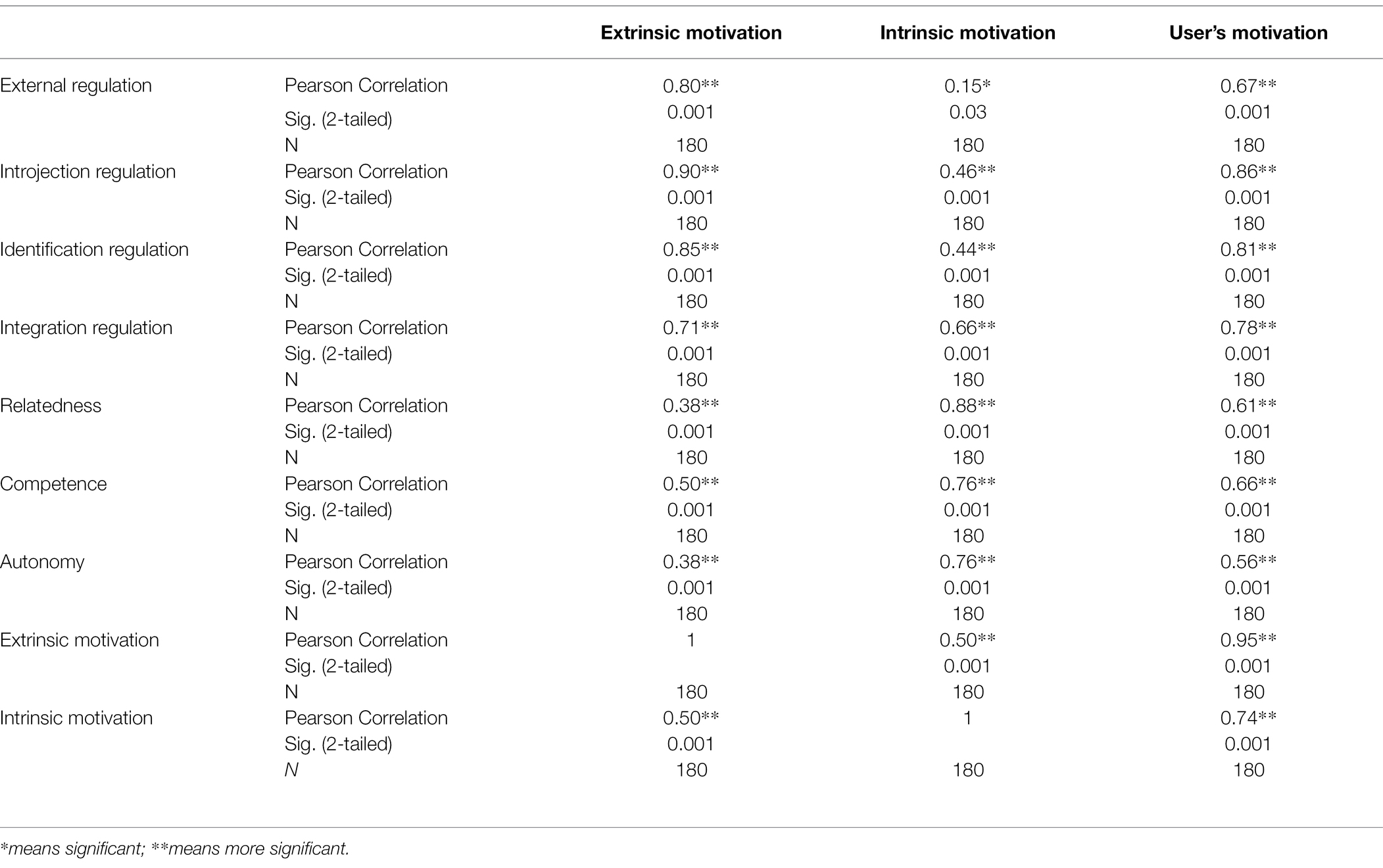- 1School of Culture and Communication, Capital University of Economics and Business, Beijing, China
- 2School of Journalism and Communication, Hebei University, Baoding, China
- 3Department of Journalism and Communication, Dalian University of Technology, Dalian, China
The sudden arrival of COVID-19 has had an enormous impact on the lives of people around the world, including significant psychological pressure and increased emotional needs. In China, research into user psychology and the motivations of commercial digital media has become more popular, but the national media should pay more attention to user psychology and perform more research on user motivations to improve the effectiveness of communication. We investigated people’s internal psychology and motivation for using national media digital platforms in China during the pandemic. We collected data through online questionnaires and analyzed the use of apps of CCTV and The People’s Daily by individual users during the pandemic and the psychological needs of national digital media users. In the first stage of our research, we selected national digital media app users through the WeChat platform. In the second stage, more active users were chosen by snowballing upon the original sample. We surveyed 210 participants and ultimately obtained 180 valid samples. We analyzed the data using used SPSS 23.0. The results showed that with the help of digital media platforms and diversified media technology, the Chinese national media not only met the needs of users for information acquisition, but also provided sufficient emotional mutual assistance and comfort to users through the network aggregation formed by digital scene communication.
Introduction
The COVID-19 pandemic has significantly disrupted the world, and global systems’ capacity to respond to rapidly changing circumstances has been under enormous pressure (Remuzzi and Remuzzi, 2020). In the midst of this, social media has played a very important role in disseminating information about the pandemic. We have observed how digital social networks facilitate the exchange of information and emotions between people who are physically isolated (Díez García et al., 2020). A significant number of people have reported symptoms of stress, anxiety, and depression throughout the outbreak, and may have increased social media use as a result (Luo, 2021). At the same time, the spread of uncertainty in the social media environment has resulted in an enormous information upheaval, creating a transmission environment for the emotional contagion of anxiety and uncertainty in which people became highly insecure and constantly subjected to potential misinformation. The WHO calls the rapid spread of excessive information in the evolution of major pandemic outbreaks the “information pandemic” (WHO, 2020). The WHO believes that the large amount of unreliable information, such as rumors, spreads rapidly and internationally via the increasing popularity of mobile phones, social media, the Internet, and other communication technologies, resulting in the public lacking immediate and effective information, and subsequently delaying necessary pandemic intervention measures. Therefore, establishing a successful information management system to provide real information to meet the needs of the public may be able to effectively deal with such a crisis.
China’s national media, such as The People’s Daily and CCTV, are the most influential and widespread media outlets in China. They continue the tradition of news communication in the era of traditional media by diving deep into the informational requirements of pandemic prevention and control, addressing the psychological needs of the people, and effectively identifying and integrating information, in stark contrast to the fragmented nature of social media and the dissemination of uncertain information. People had stronger credibility-based attitudes toward mainstream media than toward alternative media (Xiao, 2021). However, China’s national media adopts innovations in media technology and trends in traditional media technology transformation, promoting both the digital integration of media with the help of new media technologies and new communication patterns. They do this in an attempt to alleviate the negative aspects of the pandemic for their audience with immersion and empathic communication, such as “micro-communication” and “slow live broadcasting.” The media has played a key role in stabilizing the mood of the people and helping them to readjust their social lives. The digital media at the provincial, municipal, and county levels also cooperate closely with each other and show remarkable effectiveness in transmitting information.
In the post-COVID-19 era, the public’s psychological healing, social reconstruction, and social development are closely related to the media ecology. At the same time, 5G, big data, cloud network integration, and edge computing are accelerating changes in communication patterns and structures. Under the support and drive of computer technology, internet technology, and digitalization technology, digital new media is developing rapidly in China (Wu, 2019). Currently, traditional media are accelerating the transformation of digitization, mobility, and intelligence.
From the perspective of media technology shaping human perception, scholars, such as Schmidt (1998), regard the media as the coupling of communication and cognition, as well as between media, communication, cognition, and culture, ultimately forming the “reality” identified by human beings (Sun, 2020). Thus, the transformation from traditional mass media to interpersonal communication is an important factor affecting the integration and development of digital media.
Social media has become an online platform to build disaster resilience among communities (Dufty, 2012). Specifically, social media is helpful in four aspects of disaster resilience: information gathering, information dissemination, collaborative problem-solving, and coping (Jurgens and Helsloot, 2018). When viewed at a macro level, real action has implications for the community’s community resilience in facing the COVID-19 pandemic. The conversation on Twitter during disaster enriches community-based resilience (Kalaloi et al., 2021). The versatility and goal-oriented nature of WeChat groups allow many of them to serve as emergent groups because they perform non-regular tasks and expand in size rapidly in a disaster setting. This dynamic growth lets group members gather otherwise inaccessible social capital. Those who have joined and engaged more in WeChat group activities have also received more aid from a diverse range of social connections (Chu and Yang, 2020). Some studies have shown that continued consumption of COVID-19-related media may aggravate psychological anxiety and pain in some individuals. COVID-19 reports have resulted in feelings of confusion, anxiety, and panic (Dong and Zheng, 2020; Holmes et al., 2020; Lăzăroiu et al., 2020; Rommer et al., 2020; Ullah and Amin, 2020). Based on the strong impact that the media may have on individuals, and considering the impact of the pandemic and the digital development of China’s national media, facing and meeting users’ motivation is therefore crucial. The value and feasibility of the development of media digital integration is based on the needs of the audience for various media content, therefore indicating that media users tend to choose a single supplier that can meet various related needs (Gambardella and Torrisi, 1998). In the post-COVID-19 pandemic era, the analysis of the use of state media by audiences should be a prominent component of the relevant research areas of national media construction.
The analysis of audience motivation in the integration and development of mainstream media and digital media uses self-determination theory (SDT). SDT (Deci and Ryan, 1980) focuses on autonomy and has recently expanded to include studies of awareness, integrative emotion regulation, life goals, the inner compass, needs crafting, revitalization, and self-talk, among other topics and processes relevant to understanding healthy agency (Deci and Ryan, 2000). As Koestner and Holding (2021) highlight, SDT is unique in its emphasis on this concept, suggesting that SDT’s emphasis on autonomy has particular salience in the era of COVID-19, in which voluntary compliance matters to public health.
Materials and Methods
Construction of the Measurement Model and Hypothesis of Media User’s Motivation
Based on the relationship between extrinsic and intrinsic motivation of SDT (Deci and Ryan, 1980), this paper mainly discusses the dominant motivation of national digital media user behavior. As shown in Figure 1, the user’s external and internal motivations are divided into seven subvariables: external regulation, internal regulation, identity regulation, integration regulation, relevance, ability, and autonomy. Time cost has a positive impact on the classification results of the seven subdrivers. Among them, external supervision, internal supervision, identification supervision, and integrated supervision have a positive impact on the external drivers, while relevance, ability, and autonomy have a positive impact on the internal drivers, ultimately having a positive impact on the user’s motivation for using national digital media.
External regulation means that users receive additional rewards by meeting some external requirements, and these users are the least loyal in their use of national digital media applications. Integration regulation is the most internalized motivation type, meaning that individuals actively obtain information from and agree with the values and ethics transmitted by national digital media. As a result, these users are more receptive and loyal, which shows that people self-regulate their behavior, actively learn and master their own world, strive to internalize cultural norms, reflectively consider their own attitudes and values, and make informed choices (Deci and Ryan, 2000). An individual’s external behavior motivation dictates their opportunity to make their own decisions, resulting in higher levels of external motivation (Deci and Ryan, 2008).
The emotional tie of users to the country, to society, and to various groups is the specific manifestation of the internal motivation affecting users’ use of national digital media. Online interactions are positively associated with the general public’s psychological wellbeing (Yang et al., 2020). During the pandemic, users’ insightful comments on national digital media platforms are liked and forwarded by other users, and the information is shared by the community members through the national digital media apps, which can strengthen the sense of emotional belonging between users and the national digital media platform. Assumptions about the relationships of the variables are shown in Table 1.
Generation of a Multidimensional Measurement Scale for Media User’s Motivation
We randomly selected users to investigate their use of CCTV and daily apps from 20 January 2020 to 29 February 2020.
According to the characteristics of high efficiency, fragmentation, transience, interactivity, and authority of national digital media apps, the representative national digital media (CCTV and The People’s Daily apps) were selected, and a multidimensional measurement scale of relevant user motivations is proposed below. As shown in Table 2, according to SDT, the scale includes 2 primary indicators, 7 secondary indicators, and 13 measurement indicators. In addition, based on CCTV multidimensional measurement scale and the motivation of users of The People’s Daily app, the questionnaire of this study adopts the Likert method to quantify various indicators, represented by 1 = strongly disagree, 2 = disagree, 3 = uncertain, 4 = agree, and 5 = strongly agree (Table 3).
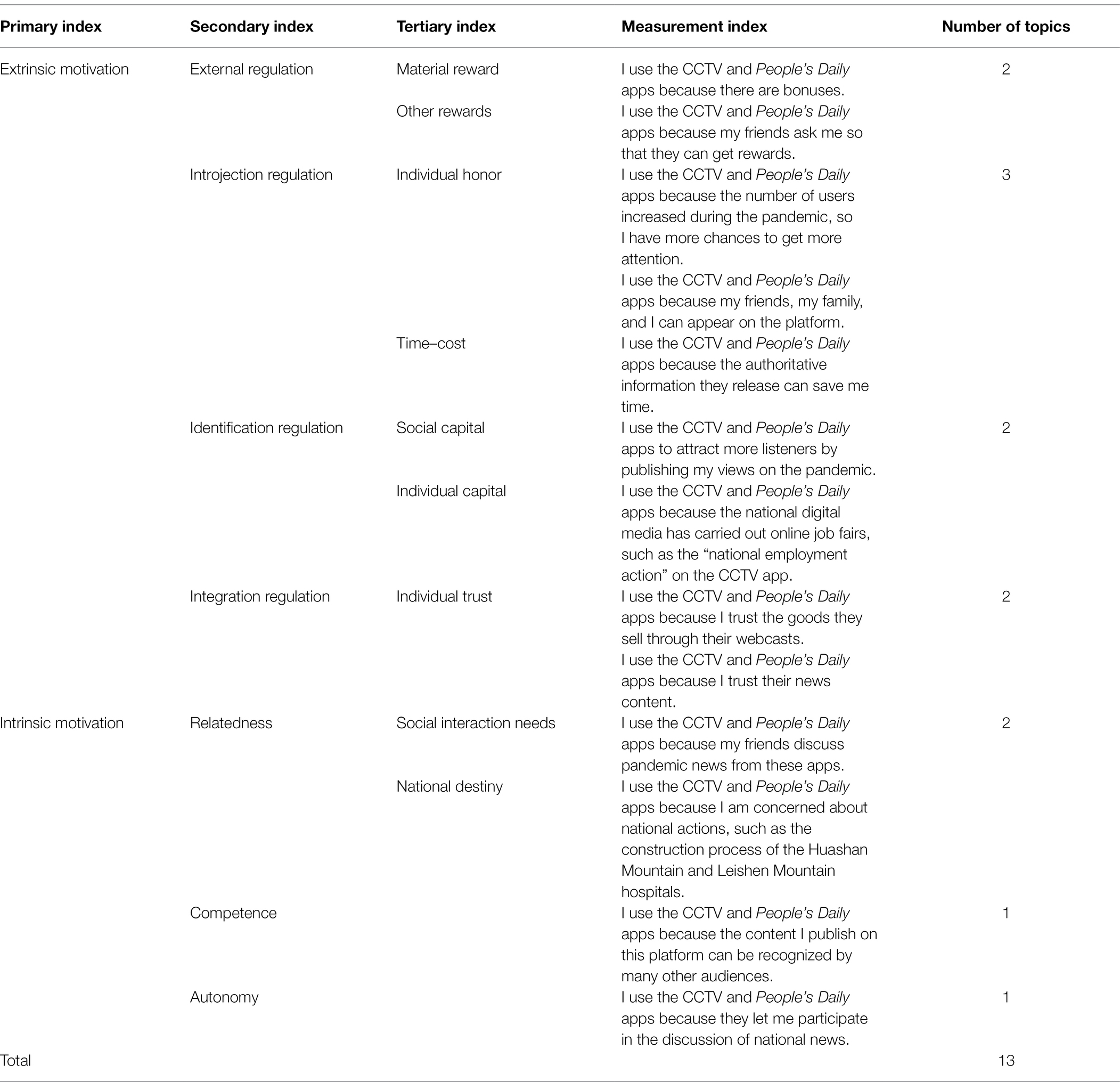
Table 2. Multidimensional measurement scale of user’s motivation of CCTV app and The People’s Daily app.
Participants
The data were obtained via online questionnaires. We selected the apps of CCTV and People’s Daily users in the high incidence stage of the pandemic (from 20 January 2020 to 29 February 2020). In the first stage, the users of national digital media apps were randomly selected through the WeChat platform as the initial parent sample. In the second stage, more active users were chosen by snowballing the parent samples. We ultimately surveyed 210 individuals and obtained 180 valid samples. Half of the sample were female, while medical personnel accounted for approximately one-third of the sample. According to the grade of China’s pandemic prevention and control, there are 62 respondents in high-risk areas, 57 in medium-risk areas, and 61 in low-risk areas.
The results show that users in high-risk areas spent 9.62 h online every day, compared to 7.21 h in medium-risk areas and 6.16 h in low-risk areas. They spent approximately 2.88 h using national digital media applications, compared to 1.59 h in medium risk areas and 1.44 h in low-risk areas. Women spent 7.85 h online every day, compared to 5.8 h for men, and that they spent approximately 1.59 h using national digital media applications, compared to men’s usage of roughly 1.58 h. Medical personnel and non-medical personnel accounted for 31.1 and 68.9% of users, respectively, and medical personnel spent approximately 5.62 h online every day, while non-medical personnel spent approximately 6.90 h on average. Moreover, medical staff spent approximately 1.33 h on national digital media apps, and non-medical staff spent approximately 1.65 h on them.
Results
Construct Validity Analysis
We used SPSS 23.0 to analyze and process all data. Internal consistency was assessed using Cronbach’s α, structural validity was explored through exploratory factor analysis, and the correlation between the indexes of the above model was assessed by correlation analysis. As shown in Table 4, the chi-square statistical value of the KMO sample measure was 0.85, and the Bartlett sphere was 1396.53, where p < 0.001, indicating good validity.
Reliability Analysis
Table 5 shows the reliability of 14 questions in the scale of from 180 questionnaires. Reliability was at 0.82, indicating good reliability.
Table 6 shows that only the correlation between identity adjustment and external drivers was significant, therefore supporting H3. It also supports the theory that users’ choice of national digital media platforms is often interest-centered and strongly influenced by personal purposes.
As in Table 6, H5 in Table 7 was similarly supported, suggesting that time-use cost is closely related to the sense of belonging. In the context of the pandemic, “contactless behavior” strengthens the audience’s online presence and permanent connection to the media, resulting in the “fear of missing out” phenomenon related to official pandemic-related information. This phenomenon also bears resemblance to the “dilemma of outsiders,” referring to the psychological state of individuals who are afraid of being excluded by the external world and fear that they will miss any changes. This was particularly a factor in the wake of the devastation provoked by the massive amount of COVID-19 deaths, often in the absence of loved ones. Among isolated people, trust guides people’s emotions. Trust is not only needed to gain access to knowledge, but it is also essential to becoming a socially situated person. It is internalized through social practices like support and cooperation (Simone and Claudia, 2021). In the wake of the social changes and turbulence brought about by the pandemic, the need for individuals to obtain real information and make emotional connections with the external world is particularly urgent (Zhou, 2020).
As shown in Table 8, the assumptions H8, H9, H10, H11, H12, H13, h14, H15, and H16 made by the above model reached significant levels (p < 0.01).
Discussion
As a result of the pandemic, non-contact behavior suddenly forced everyone to coordinate and deal with environmental, physical, psychological, and emotional discomfort and confusion on a large scale.
Media integration is not only the integration of media technology, but also the integration of collective human sensory experience and the resulting integration of emotions and thoughts. This is particularly true when people face an environment that they cannot experience personally, resulting in the closer integration of people and technology in the post-COVID-19 pandemic era.
Media integration also refers to the transformation of communication relations. The initiative, selectivity, enthusiasm, and participation of the audience play a great role, and the relationship between the media and the audience can be significantly transformed.
The national digital media should pay attention to the internal needs of people’s psychology, provide authoritative emotional support for their audience’s pressures and fears through emotional narration, and potentially alleviate negative thoughts through effective empathy.
In the post-COVID-19 pandemic era, the construction of national digital media should meet the audience’s needs to participate in the world, and build a media environment to adapt to the new ecological environment under the altered social structure.
The role of emotional communication has been extremely prominent during the pandemic. In the post-COVID-19 era, the emotional function of national digital media has gradually shifted to realizing social emotional resonance, recognition, and motivation, and promoting cognition, joint force, and investment in social co-construction. Therefore, the national media has begun to bear responsibility for the restoration and reconstruction of social order and construction, actively mobilizing and forging pathways toward emotional relief, and unifying individual emotions into a powerful force to promote the transformation of actions in the post-pandemic era.
Conclusion and Implications
Based on self-determination theory (SDT), this study analyzed the use of CCTV’s and The People’s Daily’s apps by individual users during the pandemic, as well as the psychological needs of national digital media users, and found the following. First, there is a correlation between pandemic risk and people’s media usage time. People in higher risk areas spent more time online. Second, users’ choice of national digital media applications is influenced by personal extrinsic motivation. Users’ choice of national digital media platforms is often interest-centered and strongly influenced by personal purposes. Third, users’ choice of national digital media applications is also influenced by personal intrinsic motivation. Due to the lack of sense of belonging caused by “contactless behavior” in the pandemic, the need for individuals to obtain real information and make emotional connections with the external world is particularly urgent.
In the post-COVID-19 era, emotion and social psychology are the important influencing variables of media communication. The internal needs of the media audience, therefore, should be considered and gradually become the driving force of the transformation of the production and communication modes of China’s national media. In the digital media environment, China’s national media outlets should gradually adopt a method of emotional communication to innovate and transform production mechanisms and communication modes.
Data Availability Statement
The raw data supporting the conclusions of this article will be made available by the authors, without undue reservation.
Author Contributions
YT: thesis design, drafted the paper, made important modifications to the paper, and approved the final paper to be published. XS: data collection and analysis, drafted the paper, and data verification. FW: data analysis, drafted the paper, and made important modifications to the paper. CZ: reference collection and data analysis. All authors contributed to the article and approved the submitted version.
Conflict of Interest
The authors declare that the research was conducted in the absence of any commercial or financial relationships that could be construed as a potential conflict of interest.
Publisher’s Note
All claims expressed in this article are solely those of the authors and do not necessarily represent those of their affiliated organizations, or those of the publisher, the editors and the reviewers. Any product that may be evaluated in this article, or claim that may be made by its manufacturer, is not guaranteed or endorsed by the publisher.
References
Chu, H., and Yang, J. (2020). Building disaster resilience using social messaging networks: the WeChat community in Houston, Texas, during hurricane Harvey. Disasters 44, 726–752. doi: 10.1111/disa.12388
Deci, E. L., and Ryan, R. M. (1980). Self-determination theory: when mind mediates behavior. J. Mind Behav. 1, 33–43.
Deci, E. L., and Ryan, R. M. (2000). The “what” and the “why” of goal pursuits: human needs and the self-determination of behavior. Psychol. Inq. 11, 227–268. doi: 10.1207/S15327965PLI1104_01
Deci, E. L., and Ryan, R. M. (2008). Facilitating optimal motivation and psychological well-being across Life's domains. Can. Psychol. 49, 14–23. doi: 10.1037/0708-5591.49.1.14
Díez García, R., Belli, S., and Márquez, I. (2020). La COVID-19, pantallas y reflexividad social: Cómo el brote de un patógeno está afectando nuestra cotidianidad. RES 29, 759–768. doi: 10.22325/fes/res.2020.49
Dong, M., and Zheng, J. (2020). Headline stress disorder caused by Netnews during the outbreak of COVID-19. Health Expect. 23, 259–260. doi: 10.1111/hex.13055
Dufty, N. (2012). Using social media to build community disaster resilience. Aus. J. Emerg. Manage. 27, 40–45. doi: 10.13140/rg.2.2.10495.43686
Gambardella, A., and Torrisi, S. (1998). Does technological convergence imply convergence in markets? Evidence from the electronics industry. Res. Policy 27, 445–463. doi: 10.1016/S0048-7333(98)00062-6
Holmes, E. A., O’Connor, R. C., Perry, V. H., Tracey, I., Wessely, S., Arseneault, L., et al. (2020). Multidisciplinary research priorities for the COVID-19 pandemic: A call for action for mental health science. Lancet Psychiatry 7, 547–560. doi: 10.1016/S2215-0366(20)30168-1
Jurgens, M., and Helsloot, I. (2018). The effect of social media on the dynamics of (self) resilience during disasters: A literature review. J. Contingencies Cris. Manag. 26, 79–88. doi: 10.1111/1468-5973.12212
Kalaloi, A., Primayanti, A., Dianita, I., Mahestu, G., and Dirgantara, P. (2021). “Mediated solidarity and community resilience on twitter During Covid-19 pandemic in Indonesia.” in 2021 International Conference Advancement in Data Science, E-learning and Information Systems (ICADEIS) Data Science, E-learning and Information Systems (ICADEIS), 2021 International Conference Advancement; October 1–7, 2021.
Koestner, R., and Holding, A. (2021). A generative legacy: SDT’s refined understanding of the central role of autonomy in human lives. Motiv. Sci. 7, 111–112. doi: 10.1037/mot0000221
Lăzăroiu, G., Horak, J., and Valaskova, K. (2020). Scaring ourselves to death in the time of COVID-19: pandemic awareness, virus anxiety, and contagious fear. Ling. Philos. Invest. 19, 114–120. doi: 10.22381/LPI1920208
Luo, T. (2021). Social media use in China before and during COVID-19: preliminary results from an online retrospective survey. J. Psychiatr. Res. 140, 35–38. doi: 10.1016/j.jpsychires.2021.05.057
Remuzzi, A., and Remuzzi, G. (2020). COVID-19 and Italy: what next? Lancet 395, 1225–1228. doi: 10.1016/S0140-6736(20)30627-9
Rommer, D., Majerova, J., and Machova, V. (2020). Repeated COVID-19 Pandemicrelated media consumption: minimizing sharing of nonsensical misinformation through health literacy and critical thinking. Ling. Philos. Inv. 19, 107–113. doi: 10.22381/LPI1920207
Simone, B., and Claudia, V. A. (2021). COVID-19 pandemic and emotional contagion. Digithum 27, 1–9. doi: 10.7238/d.v0i27.374153
Sun, W. (2020). On the Media of Perception—Analysis of media convergence and the practice of mass digital communication During the COVID-19 period. Shanghai J. Rev. 452, 3–14.
Ullah, R., and Amin, S. (2020). The psychological impact of COVID-19 on medical students. Psychiatry Res. 288: 113020. doi: 10.1016/j.psychres.2020.113020
WHO (2020). Novel Coronavirus (2019-nCoV): Situation Report-13 [EB/OL]. (2020–0202) [2020–0312]. Available at: https://www.who.int/docs/default-source/coronavirus/situation-reports/20200202-sitrep-13-ncov-v3.pdf.26-34 (Accessed June 26, 2020).
Wu, R. (2019). “Problems and suggestions about digital new media development in China.” in Service Systems and Service Management (ICSSSM), 2019 16th International Conference; November 24, 2019.
Xiao, W. (2021). The motivations and uses of mainstream and social media during the COVID-19 pandemic in China: A structural equation modeling approach. Comp. Hum. Behav. Rep. 4:100098. doi: 10.1016/j.chbr.2021.100098
Yang, Y., Liu, K., Li, S., and Shu, M. (2020). Social media activities, emotion regulation strategies, and their interactions on People’s mental health in COVID-19 pandemic. Int. J. Environ. Res. Public Health 17:8931. doi: 10.3390/ijerph17238931
Keywords: self-determination theory, motivation, media users, national media, post-COVID-19 pandemic era
Citation: Tan Y, She X, Zhou C and Wang F (2022) The Motivation of Media Users and China’s National Media Digitization Construction in the Post-COVID-19 Era. Front. Psychol. 13:849097. doi: 10.3389/fpsyg.2022.849097
Edited by:
George Lazaroiu, Spiru Haret University, RomaniaReviewed by:
Aurel Pera, University of Craiova, RomaniaSimone Belli, Complutense University of Madrid, Spain
Moshe Farchi, Tel-Hai College, Israel
Copyright © 2022 Tan, She, Zhou and Wang. This is an open-access article distributed under the terms of the Creative Commons Attribution License (CC BY). The use, distribution or reproduction in other forums is permitted, provided the original author(s) and the copyright owner(s) are credited and that the original publication in this journal is cited, in accordance with accepted academic practice. No use, distribution or reproduction is permitted which does not comply with these terms.
*Correspondence: Fangfei Wang, ZmVpODgyMUAxNjMuY29t
 Yufei Tan
Yufei Tan Xinlin She1
Xinlin She1 Fangfei Wang
Fangfei Wang